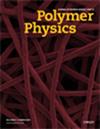Water-sorption behaviors of poly(3,4'-oxydiphenylene pyromellitimide) films depending on the thickness variation
3区 工程技术
Q1 Materials Science
Journal of Polymer Science. Part B, Polymer Physics
Pub Date : 2001-03-15
DOI:10.1002/1099-0488(20010315)39:6<669::AID-POLB1041>3.0.CO;2-#
引用次数: 15
Abstract
The effect of film thickness on the water-sorption behaviors of poly(3,4′-oxydiphenylene pyromellitimide) (PMDA-3,4′ODA) films was gravimetrically investigated and interpreted with a Fickian diffusion model in films. The diffusion coefficient increased with increasing film thickness, whereas the water uptake and the activation energy decreased. Overall, the water-sorption behaviors of PMDA-3,4′ODA films are strongly dependent on the changes in morphological structure, which originated from the variation in the film thickness. As the film thickness increased, the molecular in-plane orientation decreased, consequently leading to the increased diffusion coefficient and decreased activation energy. In contrast, the water uptake decreased with increasing film thickness because of the increase in the out-of-plane packing order. The diffusion coefficient and activation energy were strongly dependent on the in-plane orientation in the films. © 2001 John Wiley & Sons, Inc. J Polym Sci B: Polym Phys 39: 669–676, 2001聚(3,4'-氧基二苯二胺)薄膜随厚度变化的吸水行为
用重量法研究了膜厚对聚(3,4’-氧基二苯二胺)(pmda -3,4’oda)膜吸水行为的影响,并用Fickian膜内扩散模型进行了解释。扩散系数随膜厚的增加而增大,吸水量和活化能则减小。总体而言,pmda -3,4 ' oda膜的吸水行为强烈依赖于形态结构的变化,而形态结构的变化源于膜厚度的变化。随着膜厚的增加,分子的面内取向减小,扩散系数增大,活化能降低。相反,吸水率随着膜厚的增加而降低,这是由于面外包装顺序的增加。扩散系数和活化能与膜的面内取向密切相关。©2001 John Wiley & Sons, Inc[J] .高分子材料学报,2009,31 (2):669-676
本文章由计算机程序翻译,如有差异,请以英文原文为准。
求助全文
约1分钟内获得全文
求助全文
来源期刊
CiteScore
5.90
自引率
0.00%
发文量
0
审稿时长
2.1 months
期刊介绍:
Since its launch in 1946 by P. M. Doty, H. Mark, and C.C. Price, the Journal of Polymer Science has provided a continuous forum for the dissemination of thoroughly peer-reviewed, fundamental, international research into the preparation and properties of macromolecules.
From January 2020, the Journal of Polymer Science, Part A: Polymer Chemistry and Journal of Polymer Science, Part B: Polymer Physics will be published as one journal, the Journal of Polymer Science. The merged journal will reflect the nature of today''s polymer science research, with physics and chemistry of polymer systems at the heart of the scope.
You can continue looking forward to an exciting mix of comprehensive reviews, visionary insights, high-impact communications, and full papers that represent the rapid multidisciplinary developments in polymer science.
Our editorial team consists of a mix of well-known academic editors and full-time professional editors who ensure fast, professional peer review of your contribution. After publication, our team will work to ensure that your paper receives the recognition it deserves by your peers and the broader scientific community.

 求助内容:
求助内容: 应助结果提醒方式:
应助结果提醒方式:


